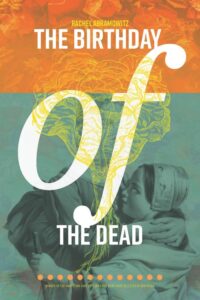 Today’s special guest is poet Rachel Abramowitz and we’re chatting about her new chapbook, The Birthday of the Dead.
Today’s special guest is poet Rachel Abramowitz and we’re chatting about her new chapbook, The Birthday of the Dead.
Bio:
Rachel Abramowitz is the author of The Birthday of the Dead, winner of the 2021 Marystina Santiestevan prize from Conduit Books, the chapbooks The Puzzle Monster, winner of the 2021 Tomaž Šalamun prize (forthcoming from Factory Hollow Press in 2022), and Gut Lust, the winner of the 2019 Burnside Review prize (Burnside Review Press, 2020). Her poems and reviews have appeared in Tin House Online, The Threepenny Review, Seneca Review, The Kenyon Review Online, Crazyhorse, Tupelo Quarterly, Prelude, POOL, jubilat, Sprung Formal, Colorado Review, and others. She is a graduate of the Iowa Writers’ Workshop and the University of Oxford, and has taught English Literature at Barnard College in New York.
What do you enjoy most about writing poems?
I both fear and, when I actually get into it, enjoy the odd trance-like state I slip into while writing poems. It feels a little like smearing a glob of Vaseline over a lens—everything goes a bit blurry, and I really have to spend time staring at images in my mind for them to become comprehensible. I can’t stay in this mode for long; when I finish a poem (and they’re usually short—I haven’t been able to sustain the state long enough to write long poems) and snap out of it, it’s a bit of a relief!
Can you give us a little insight into a few of your poems – perhaps a couple of your favorites?
One of my favorite poems is “Drosophila melanogaster,” which collapses an observation of fruit flies swarming a rotting banana with a projection of what the Pope might be doing in the Vatican, alone, with all those treasures at his fingertips. While of course they come from somewhere, fruit flies always seem divinely conjured, just appearing one day to herald the visible moment of entropy. I like to imagine the Pope becoming distracted at an important theological (or, I suppose, administrative) meeting by a fruit fly, which (in this vision) is a kind of annoying memento mori. Yes, the ancient statues in his collection will outlive him, but they, too, will crumble, Ozymandias-style. Eternity and impermanence in a single fruit fly, etc.
Another is “In a Past Life,” which ends with a nod to the anecdotal “fact” that so many past-life seekers are told that they are a reincarnation of Cleopatra—who wouldn’t want to believe that?
What form are you inspired to write in the most? Why?
I would love to write in more traditional forms! Some of my favorite contemporary poets write in form (sestinas, villanelles, and ghazals, oh my!), and their creative control absolutely astonishes me. I will write a poem with a first guess at line breaks, somewhat side-eyeing a form that seems to be emerging, and then try to use the space of the page to tease it out. I’ve had wonderful editors who have encouraged me to use the page more, which I hope will, in time, lead me villanelle-ward.
What type of project are you working on next?
I’ve started work on a second full-length collection; although it came together in the end (I hope), the first book was less of a “project” than this one. I’m excited to see what happens when the writing is more directionally deliberate.
When did you first consider yourself a writer / poet?
I wrote a sonnet (ha! Form!) in 8th grade under the excellent tutelage of Mrs. Siegal. It was pretty over the top, image-wise, but I loved the feeling of using language to transport myself. From then on, I was happily doomed.
How do you research markets for your work, perhaps as some advice for not-yet-published poets?
When you find a poet you like, see where they’ve published! If you can get your hands on one of their books, check out the Acknowledgments page to see where individual poems have appeared. Reading those journals may lead you to other poets with whom you resonate, and the rabbit hole deepens!
What would you say is your interesting writing quirk?
I rotate two or three “talisman” books—books of poems or criticism that I have to have next to my writing space. Dipping into them for a few minutes before beginning to write creates that incantatory, Vaseline-globby space that helps me start writing. I also generally have a giant Maine Coon cat on my lap.
As a child, what did you want to be when you grew up?
Like a lot of kids, I figured I could be several things at once; I think at one point it was “astronaut-gymnast-zookeeper.” Writing is the only occupation I’ve found that allows for this kind of multi-existence—although I would love to be able to do an actual cartwheel sometime.
